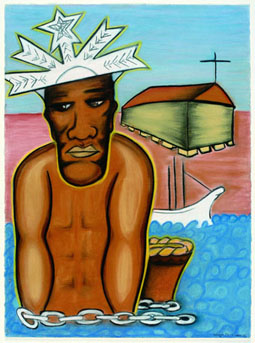Adelaide Festival 2004: Stories from Australia
Jeremy Eccles

Kathryn Norris, The Coming of the Light, 1996
The Museum of Australia’s currently touring Indigenous exhibition, Stories from Australia, was never supposed to be seen in this country. Dawn Casey was insistent on this point when the exhibition was created especially for the Guangzhou Museum of Art as part of the 30th anniversary of diplomatic relations between Australia and China. Guangzhou initiated the exhibition: they wanted a great show to outshine Beijing. Local businessmen had seen Aboriginal culture in Australia and saw it as a vehicle to promote tourism and educational links with our country, and they were prepared to pay much of the cost. But what they and the Museum wanted didn’t necessarily coincide with the former NMA Director’s agenda. She told me at the time that she didn’t want to reinforce stereotypes about a “past beautiful” culture.
But a diverse and dynamic picture of the Dreaming is emerging at the Adelaide Festival, and that’s as true of Stories from Australia as any other part of the event. Despite his efforts to play down the Indigenous core of the festival, Stephen Page has created a fascinatingly non-prescriptive mix. His only agenda seems to be to make an Aboriginal and Torres Strait Islander presence seem entirely normal in a major south-eastern city festival. It’s already pretty normal in the west.
The module system designed for Stories from Australia produces a fairly episodic picture, with only bare links between the various components. It also seems that Tandanya could only fit parts of the show in, so we’re missing a module dear to the NMA: film of the Wik people dancing in 1962 when they created an important set of Flying Fox and Bonefish sculptures for the Museum. When they eventually saw their work 40 years later, after all the exigencies that delayed the NMA’s opening, the result was an explosion of ceremony and sculpting on Cape York.
And that’s exactly what Stories is trying to reveal: cultural renewal. So there’s Rover Thomas and Paddy Jaminji’s Kurirr Kurirr Ceremony, dreamed in 1974, which is an inspiration in the Kimberly (though I’ve never heard of Rover “composing” it before—a very Western concept!).
There’s also the Yirrkala’s 300 year long relationship with the Macassans, collecting trepang (sea cucumbers) for the insatiable Chinese market. This story was presumably chosen specially for the exhibition’s original Chinese audience. The relationship appears in barks and photographs, but the captions reveal that the Macassans had a deep impact on the Arnhemlander’s psyche, changing burial rituals and being awarded rock formations, the ultimate acceptance into country. This surely suggests an openness and flexibility to which a more sensitive white invasion force could have responded.
Interestingly, that astute elder from Yirrkala, Munduwuy Yunupingu (of Yothu Yindi fame) is planning a Garma Festival project which will bring songmen together from all over north east Arhemland to compare their reportage of the Macassans. Yunupingu spoke at the Adelaide Festival’s Sacred Symposium, a broad-church gathering of the Aboriginal clans in which they talked about the sacred in their particular lives. There was also an exhibition exploring the Christian in Aboriginal art, entitled Holy, Holy, Holy. Not much great art—where was George Mung Mung’s gorgeous Mary of Warmun?—but certainly an interesting diversity to the works.
Stories similarly dealt with Christianity in the Torres Strait, displaying costumes and photos of the Coming of the Light ceremony on Saibai Island, which annually celebrates the arrival of the missionaries. There was also a riposte from contemporary artist Kathryn Norris. In a surprisingly McCahonesque way, she portrays a chained Islander against images of a troubled Paradise. I wonder what the Chinese made of this inconsistency, especially as the Sabai dancers appeared live in Guangzhou.
But down the road at Yarrabah, North Queensland, the exhibition’s captions focus on cultural renewal in the community where the Reverend Ernest Gribble tried so hard to overcome the rainforest battle culture. The Queensland Art Gallery’s Cape York show last year revealed powerful new shields and spears emerging in the area, although nothing in Stories post-dates 1970! Mind you, possibly the stand-out piece of the entire exhibition is an exquisite bicornual basket from 1900.
Then there’s Papunya, surely the best publicised site of cultural renewal in the country. But it’s represented only by beads, batik and pokerwork-marked animal sculptures. Meanwhile a gorgeous canvas by Uta Uta Jangala hangs elsewhere, not related back to the Papunya module.
Dawn Casey’s philosophical doubts might have been justified with the module on the Ngarrindjeri, the Murray River’s proud guardians. While Ian Abdulla’s naïve paintings of his childhood by the river are about cultural renewal in the present, the unregenerate past is also there in the form of George Angus’ Painting of the Natives from 1844. Captions explain that the old images have helped contemporary Ngarrindjeri learn the design and deployment of their weaponry. Not a problem in Yarrabah! But as Aden Ridgeway pointed out in the Sacred Symposium, the painstaking rediscovery of the old ways (in his case the language of his North Coast people) is bound to be easier in country. But 70% of Aborigines now live out of country in Australian cities.
Will Stories from Australia travel on? It remains to be seen what the new NMA management will think. But it has found a generous context here at the Adelaide Festival, which may be un-reproduceable elsewhere, even in Canberra. Not that our southern cities don’t need regular exposure to the full range of Indigenous culture. And that has to include the likes of Djakapurra Munyurryin’s brilliant dancers from Yirrkala in the festival, who were all dust, intensity and just enough explanation to be able to read the public levels of their dynamic Dreaming.
–
Tandanya National Aboriginal Cultural Institute, from Feb 26
RealTime issue #60 April-May 2004 pg. 29






